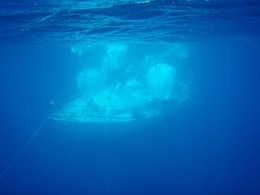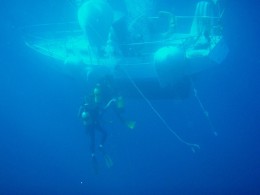The Fall and Rise of Duck (DIY salvage)
What would you do if your boat sank?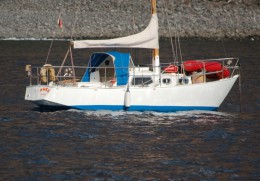
The sun was sinking towards the sea. The crew were scattered about the cockpit enjoying a glass of wine. The day had been gorgeous; although perhaps not quite so gorgeous as the ones which preceded it, because the anchorage had been beset by an unusually big and very annoying swell. By evening time, however, we had all grown accustomed to the rolling, and we were paying scant attention to anything except the golden light on the orange-brown cliffs and the ruby nectar in our glasses. Just another day in paradise… until Caesar suddenly said, “Look at that boat! It’s sinking!”
The boat in question had hitherto been an insignificant member of the little community of cruising yachts anchored in the bay. She carried no flag, so that one didn’t really know in what language to address her owner; and besides that, her owner was hardly ever aboard. She was a hard chine steel yacht of about 28 feet; much smaller than the average cruising boat of today, although she would not have looked out of place twenty years ago when we all made do with less.
Painted across the yacht’s trim little stern was the word DUCK. We had all agreed that it was a silly sort of a name, but somehow rather friendly and rather apt. We had never seen Duck undersail; she just sat there, bobbing about like a bath toy. But now she was not bobbing. Jumping to our feet we saw that Caesar was right. The little yacht was well down on her lines.
Nick hopped into the dinghy and before any of us could follow him he was pulling towards the casualty. He arrived to find the cockpit awash, and he could hear water gushing into the boat. She was already so perilously low on her lines that he did not dare to enter the cabin. Indeed, he did not even dare to tie up the dinghy in case it went down with the ship. He just hopped aboard with the painter still in his hand and peered in through the open companion way. Already the cabin below him was flooded to waist level.
What could be done to save the boat?
Duck was filling up so fast that hunting around for the seacocks and turning them off was not an option.
Nor was there any hope of saving the situation with a manual bilge pump – supposing, in any case, that Nick could find the pump in this unknown boat.
Mollymawk carries a free-standing petrol-driven pump, but the water was gushing in so fast that Nick was convinced that not even this could save the day. In any event, he would not be able to row back to Molly, get the pump on deck and get back to Duck before she took a dive.
P2 VIDEO
Concluding that there was actually nothing at all that he could do Nick hopped back into the dinghy and waited. A bare five minutes later the little boat began to lurch backwards as her stern disappeared under the water. Caesar was on the phone at this same moment, trying to arouse the interest of the local emergency services, and I heard him say, “It’s too late; it’s going now…”
The bow stayed up – as if clutching at the sky – for a surprising length of time. Then it, too, was pulled beneath the water.
The mast slid down, with all the poignancy of a flag lowered at a state funeral.
And that was that.
Duck was gone.
If her owner had come back that evening, unknowing, he would probably have stared about in disbelief saying, “Someone’s stolen my boat.”
So near and yet so far away
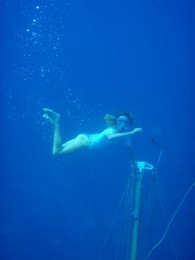
The following morning we swam over to look at the wreck – but we felt bad about even using that word.
Others, who were strangers to the situation, said that it gave them the creeps to look down on the wreck, but we didn’t see it that way. We saw a yacht – not a lost cause, but a going concern – which was only just out of our reach.
Only a few hours ago this vessel had been a trim little sloop. She was somebody’s pride and joy.
Word had now reached us concerning the owner, who was said to be a very friendly and likeable German called Ralf. He had spent a long time scraping together the money to buy a boat, and he had spent even longer doing her up. He didn’t really know how to sail, we were told, but a friend had been going to take him out this coming weekend and give him some lessons.
We gazed down through the limpid blue water; 12 metres down. The yacht was just as she had always been. There was absolutely nothing wrong with her!
She was so near – the top of her mast, as she lay there on her starboard bilge, was only two metres below the surface – and yet she was so impossibly far away.
The whole thing seemed ridiculous. Bizarre. Surreal. And we told ourselves, “It must be possible to save her; it MUST be.”
But how?
Hands off!
It is odd how people sometimes behave when a boat comes to grief. Although she was not locked, while Duck was afloat no one would have thought of boarding the boat or taking anything, but as soon as she was “a wreck” people began to talk about salvaging the anchor, or the solar panels, or the warps; and not on behalf of the owner but for themselves! Thus, ironically, the first job for the hapless Ralf was to remove any loose items and lock the cabin door.
What Dunnit?
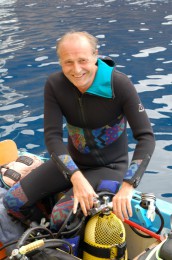
After his continuing interest in his vessel had been clearly stated, the owner’s next priority was to establish the cause of the sinking. When he first arrived on the scene Ralf expected to find a big hole in the bottom of the hull, and someone else suggested sabotage, but you don’t have to have been messing about in boats for very long to know that the usual cause of a boat going down on her moorings is one of those small holes installed by the owner. Since the boat was a steel one, Nick plumped for the seawater cooling inlet – he reckoned that it had rusted away from the side of the boat – but, as it happens, Duck didn’t have one of these; she was fresh water cooled, like our own boat, from water carried in the keel.
Myself, I reckoned that the toilet inlet was the culprit. I pointed out that the boat had spent the day rolling to and fro like a pig in a wallow. “Do you leave your toilet seacock open?” I asked Ralf.
“Yes…”
“Well then – the rolling has probably pumped and siphoned water up into the loo until the level was such that it overflowed.”
Ralf appeared doubtful about this idea.
“Well what other holes do you have in your hull?” we asked. “Is there an echo-sounder? A log…?”
There were only two other holes, said Ralf, and they were both seacocks. One of them carried the out-pourings from an electric bilge pump.
“Block off all of the holes,” we said, “and we’ll worry about that problem after we’ve got her up.”
How do you raise a wreck?
None of us had ever tried raising a boat before – indeed, none of us had ever even watched a boat being raised – but it seemed straightforward enough. All we needed to do was to attach some kind of floats to the boat. 40 gallon oil drums would do the job – but oil drums are not so easy to come by in this modern age, and we couldn’t recall seeing any kicking about the place.
Something else then. Jerrycans were considered, but we quickly realised that we would need more than could be mustered in this small anchorage; to be exact, in order to lift the four or five tons of the boat we would need 200 five gallon jerry cans. Even if we had been able to rustle up that number we could not have got them all securely lashed to the boat
In reality, oil drums are now as obsolete in the salvage game as they are in the business of shifting fuel. Lift bags are the name of the game for the professionals.
Perhaps we could make some lift-bags. We could sew webbing strops over the top of a dozen flour sacks and line them with big black dustbin bags… But would they be strong enough?
Happily we did not have to go to this trouble because it turned out that Ralf and his friends had access, through the local diving club, to a number of ready-made, tough PVC lift bags. He could also make use of the club’s bottles and their compressor; so, filling the lift bags was not going to be a problem.
The only remaining requirement was for a plan of action, and that seemed simple enough. All we had to do was to lash the bags to the boat and fill them with air from the bottles. With enough air pulling her upwards the boat would rise, and once she was at the surface we would pump her out using the petrol driven machine.
“Piece o’ cake.”
There being a surfeit of volunteer divers, the five best were selected. These were: the owner, his German friend Tostin, a local Gomeran named Juan Carlos, an Argentinian called Luis, and Mollymawk’s 3rd officer, Caesar.
The lack of a common language was no problem because divers speak with their hands, but during their pre-dive briefing the team communicated in Spanish.
This is what they did:
Caesar’s Notes
“1st Attempt :
Lift bags :
1 x 4500 kg
2 x 1000 kg
1 x 500 kg
1 x 200 kg
1 x 100 kg
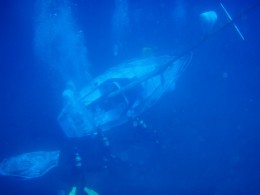
The boat was initially leaning to starboard. We put the 100 kg bag at the spreaders and inflated it to help to encourage the boat to right. I don’t think this had any effect.
Juan Carlos and I put the two 1 tonne bags on either side of the bow. They were tied together on a short rope at the front of the keel, with a second line running aft to cleats on each side of the deck. This second line was intended to stop the bags from slipping forward and escaping from under the boat. The bags were higher than I would have liked.
Tostin, Luis, and Ralph fixed the 4.5 tonne bag at the stern, with ropes leading beneath the boat and up through the cockpit drains.
We also put the 500 kg bag on the port side, at the after end of the cockpit, and the 200 kg bag on the starboard side.
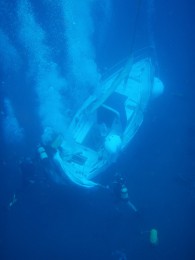
When the bags were all in place we inflated them a little, and then we began to inflate the starboard bags to right the boat and stand her on her keel.”
Aware that balance was a key issue the team filled the bags slowly and carefully – but not quite slowly and carefully enough. There was a sudden flurry, and the mast slashed through the water as the boat rolled over onto her opposite side.
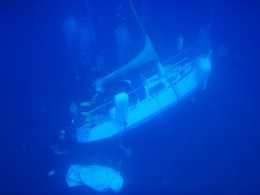
The team surfaced to change their bottles. When they tried again Caesar and Juan-Carlos filled the for’ard bags too full too suddenly, with the result that the bow suddenly shot up into the air – again with much mast waving.
“The bow began to rise rapidly. This brought a lot of sudden strain onto the line which held the bow bags in place, tearing both cleats apart and damaging the guardrail. Then the rope itself broke, and the bags slipped out under the bow and shot to the surface. The boat fell back onto its starboard side again.
We surfaced to discuss tactics…”
The principle lesson learnt from this first attempt was to fill the bags carefully. Even more carefully than the team had imagined… The secondary one was never to tie a lift bag to anything which could not bear the weight that the lift bag was capable of supporting.
Take Two
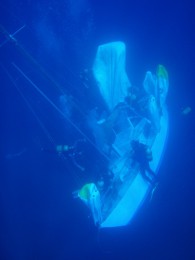
“2nd Attempt :
Lift bags :
As before, plus another 100 kg.
We decided that the 4.5 tonne lift bag was too unwieldy to place under the boat and so we put it above the boom, with six ropes tying it down to the scuppers. The ropes passed through six D-rings on the bag and were then tied back down to the opposite scupper.
We inflated this bag to hold the boat upright, and then we filled the aft bags completely and the for’ard bags a little. (We didn’t want the bow to rise too fast again…)”
The big bag had now served its purpose. Because it was set so high up it could not assist in getting the boat to the surface and so it was removed. The other bags were then completely filled, and… absolutely nothing happened. According to Ralf, the boat weighed 4 tonnes, and the remaining five bags just didn’t have the capacity to lift it.
Try, Try, Try Again
“3rd Attempt :
Lift bags :
1 x 4500 kg
6 x 1000 kg
1 x 100 kg
Ralph having managed to borrow four more 1 tonne lift bags, from a professional outfit, we tried again.
We started by putting the 100kg bag on the mast, as before, and the 4.5 tonne bag above the boom. These were inflated sufficiently to stand the boat up.”
The one ton bags were then tied to the boat, particular care being taken to position them as low as was possible. When all was ready the bags were carefully inflated, little by little.
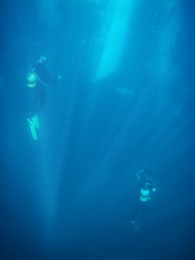
“Unfortunately, we inflated the for’ard ones too much and the bow shot up much faster than the stern. Again. Once again, the rope securing two of the bags broke; and again the bags shot out forwards. This time they went up on either side of the anchor chain, and being roped together still they lifted the chain. The bow, having begun to rise while the bags were still in place, now fell back to the ground. The stern continued to rise causing the boat to go cart-wheeling around, with the mast waving about in an alarming fashion. Still supported by the four aft bags, the boat came to rest with its stern about one metre below the surface and its bow about one metre from the seabed.
The boat sat in this way while we surfaced to discuss the matter. Eventually, being cold and tired and having no idea how to proceed, we decided to call it a day. We let the bags down, allowing the boat to fall back to the seabed.”
Lateral thinking thwarted
Having considered their experiences, the team decided that they would never be able to lift the boat to the surface and pump her out, in the way that they had intended. With the bags set low down the boat was highly unstable and small adjustments to the amount of air in each one threw her all over the place. But with the bags set higher up, so that they pulled from above and the boat remained stable, the deck couldn’t be brought clear of the surface.
The only hope, it seemed, was to raise the boat with the bags fixed above it and then tow it into the port. If we tied the boat to the wall at high tide it would hang there as the tide began to fall away, and we could then pump it out. Alternatively, we could tow it into the port, lean it on the wall, and have it craned out. Unfortunately, the port authorities refused to grant permission for the vessel to enter harbour in this novel manner unless she had insurance. And no one wants to insure a boat which has already sunk.
Back to the drawing board
The idea for the next salvage bid came from another yotty who claimed to have used the method himself, in the Caribbean. If you can seal the boat, he said, then you should be able to pump out the water.
“All you need is another pipe, leading down from the surface.”
According to the theory, as the water vacated the cabin its place would be taken by air rushing down the pipe to fill the vacuum.
“4th Attempt :
Lift bags :
1 x 4500 kg
6 x 1000 kg
1 x 500 kg
1 x 200 kg
We decided to lift the boat to just below the surface, with the bags positioned above it so that it would be more stable. We would then begin to pump water out from the boat, with it still just below the surface. Pumping the water out would reduce the pressure inside the cabin (assuming that we sealed everything well), and suck air in through a second pipe which was to be attached at the opposite end, leading down from the surface.
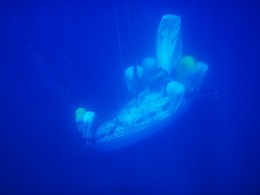
In the morning, Juan Carlos, Ralph, and I went down and attached the bags. We then prepared the two pipes – one, which was to enter through a ventilation hole in the lazarette hatch, for the bilge pump; the other, which entered through a similar hole in the forehatch, for the air-feed pipe.
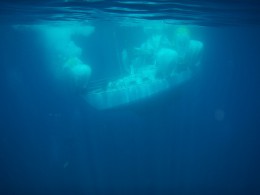
When Tosten and Luis came we stood the boat up with the 4.5 tonne bag, as before. We inflated the 1 tonne bags enough to hold the boat upright, and then we removed the 4.5 tonne bag completely. We then inflated all the other bags little by little, until the boat slowly lifted off the bottom and rose neatly and evenly to the surface in a controlled manner.
Success!
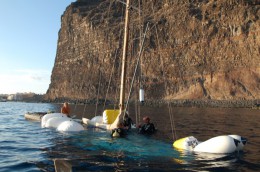
Now we had to pump the boat out. We connected the pump hose, and Nick started the pump. Then we went round the boat with dustbin bags sealing any leaks which we came across. (The leaks were easy to find: we simply passed along the boat with a plastic bag in one hand. If we felt the plastic being sucked onto the boat then we knew that there was a leak.) The main leaks were at the edges of the cockpit sole, and around the main hatch.
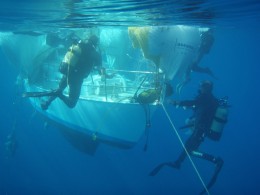
The water was pumped out and the air entered, according to plan. The boat rose by about half a metre. Through the windows we could see that the air was filling most of the coach roof.”
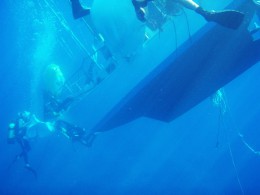
But then, suddenly, everything went wrong.
The men were all busily circling around the boat checking for leaks and no one noticed that the lift bags were steadily leaking. One moment all was well, and then, in the next instant, the bow suddenly began to plummet. As it sank, the air rushed to the stern of the boat and promptly escaped via the leaking hatch…!
Naturally, the men reacted swiftly, but by the time the bow was back at the surface we were back to the starting point.
During the little debacle the pump had sucked air and stalled. Nick got it going again, intending to repeat the exercise – but this time the air simply would not enter the boat. The pressure inside was lowered, by the pump, to the extent that the companion hatch started to break and the boards started to cave in; but absolutely no air entered the cabin.
Something had obviously changed. We checked the air pipe, but it was still clear.
If the pump had not succeeded, on the first occasion, in swiftly drawing air into the boat then we would quickly have given up this plan and turned to another – we might have turned our attention to moving the lift bags down, for instance, in order to raise the deck out of the water – but as it was we all refused to accept that what had happened once could not necessarily be made to happen again.
To this day we still don’t know why the method worked the first time but not the second time.
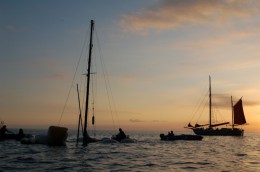
The sun slid down through the sky, blazing a golden trail across the water. Our minds seemed frozen. We all knew what was needed – we just needed to lift the boat up a tiny bit more – but we couldn’t see how we could do it without more bags.
Someone suggested running the submerged boat up the beach, in the port. It was so nearly dark now that the authorities would hardly be likely to notice us, and in this part of the world a fait accompli is a victory.
“Besides,” we told our German friend, “you’ll be able to get the boat off again before daybreak. We’ll tow her in, the tide will fall, you’ll bale her out… and when the tide comes back she’ll float off. The port captain will never even know about it!”
However, Ralf would not contemplate performing such an act of civil disobedience.
We were so very near to victory that the idea of letting go again, and letting the boat sink, was unbearable. But in the end, that is what we had to do. Darkness fell, and the men released the air and lowered Duck to the seabed again.
Total and abject failure.
Over to the Pro
Having thought the matter through, Caesar was convinced that he now knew how to lift Duck – but the other members of the team were not interested; they had had enough of the game.
Ralf got in touch with the fellow who had lent him the lift bags and three days later we found ourselves face to face with a man whom Nick and I immediately identified as a “cowboy”. He was too cool, too arrogant, and too keen on doing the job without anyone else joining him in the water. Well, that was tough luck, because not for the world would Caesar and I have missed the last act in this drama.
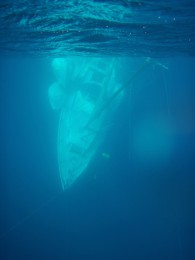
The salvor jumped in, glanced down at the boat, and said, “Pah! Easy!”
His first move was to wantonly slash at all of the running rigging, thereby needlessly destroying the mainsheet, the genoa sheets, and various other lines which were doing no harm. He also broke off the tiller.
After that little tantrum, he got down to work – and he did exactly what Caesar had now hit upon as the only means of success: in order to be able to position the bags either above the hull or alongside it, as the situation demanded, he put a stout rope round the keel. Then he attached the bags to the rope. With half hitches.
Hmmm….
Although he knew where to fasten the bags, Our Hero certainly didn’t understand about the position of the centre of gravity in a semi-long-keeled yacht. For his first effort he lifted the boat in such a way that she rose bow first from the seabed. Then his knots slipped… and down she came again, stern first.
For his second try the fellow brought the boat up on her beam. Well, it was not a very professional approach, we told each other – “when you think of all the trouble we went to, to bring her up in trim” – but perhaps it was not so very important. Then he dropped her again, onto her nose this time so that she really was “up tails all”.
After that, the cowboy wanted to run the boat ashore, onto the rocks, in this topsy-turvy attitude. Ralf was so naive and trusting – and so desperate – that he would have let him do it, but fortunately the knots slipped – again… and down went Duck, for the umpteenth time.
Then, finally, a small miracle occurred. Perhaps the Fates finally gave up trying to outwit people who were clearly not ever going to give up trying. In any event, when he brought the yacht to the surface for a third time the man somehow succeeded in keeping her upright.
After that it was a cinch. Yes, really it was! Working his way around the boat in a logical manner the salvor gradually lowered most of the bags, until the deck was clear of the water. The fact that he had eight 1 tonne bags certainly made the job easier, but Caesar still believes that it would probably have been just about feasible with the six that he and Tostin had to play with – if only he had spent the time, that afternoon, putting a rope around the keel, instead of spending it trying to persuade the pump to do the impossible.
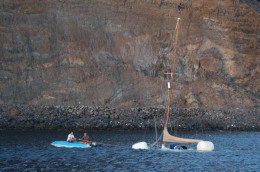
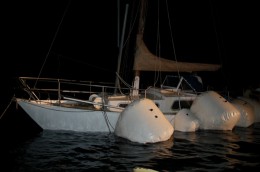
With the deck awash, Nick was soon able to empty the boat, and by evening time Duck was lying as happily as any other yacht in the anchorage.
Aftermath
Of course, for Ralf this happy ending was really only a new beginning. A steel boat which has spent three weeks on the seabed is a boat with a problem. First her engine must be salvaged. This is an urgent matter but it is not as hard as it sounds. The electrics will be useless, of course, but the rest will be unharmed provided that it is promptly flushed through with fresh water and then with a mixture of engine oil and diesel.
After that there is the hull to think of. If it is not to rust, the entire boat will need to be hosed down, on the inside, with fresh water. This will inevitably involve removing the furnishings and, in all probability, the insulation. Having glanced into Duck’s sodden and diesel soaked cabin I reckoned that the best thing to do would be to tear it all out and begin again. After all, interior grade plywood which has spent three weeks under water is almost certain to delaminate soon.
In effect, Ralf has got his boat back – and now he has to build her.
When did you last check your seacocks?
Of course, one of the first things that Ralf had to do was to ascertain the cause of the disaster. Since there was no hull damage, and since the seacocks were all intact, the sinking can only be due to one of two causes: the toilet, or the electric bilge pump. Neither of these items broke, but one or other of them siphoned water into the boat while she was rolling.
Ralf held the bilge pump to be the likeliest candidate, because he had actually seen it siphon water while the boat was under sail (…!) Water is able to pass in either direction through a submersible electric bilge pump. Thus, when he connected the bilge pump to the cockpit drain the builder should have fitted a “swan’s neck” and ensured that the top of the pipe could never be below the level of the sea.
In Conclusion
Although we believe that we now have the knowledge which would enable us to salvage a sunken yacht from relatively shallow water, the most obvious thing we have learnt is that it is far, far easier to save a boat from sinking than it is to salvage it afterwards. The day after the event it occurred to Nick that all he really needed to have done, to save Duck, was to get in the water, outside the boat, and put his hands over any outlets. When he found the right outlet, the noisy waterfall inside the cabin would promptly cease.
Mind you, since he had chosen to rush off on his own this would have left Action Man in much the same predicament as the little Dutch boy…
For more details about the lifting of Duck read Jill’s article, Duck Takes a Dive, published in Yachting World. You can download it from the YBW site for £6.95.

